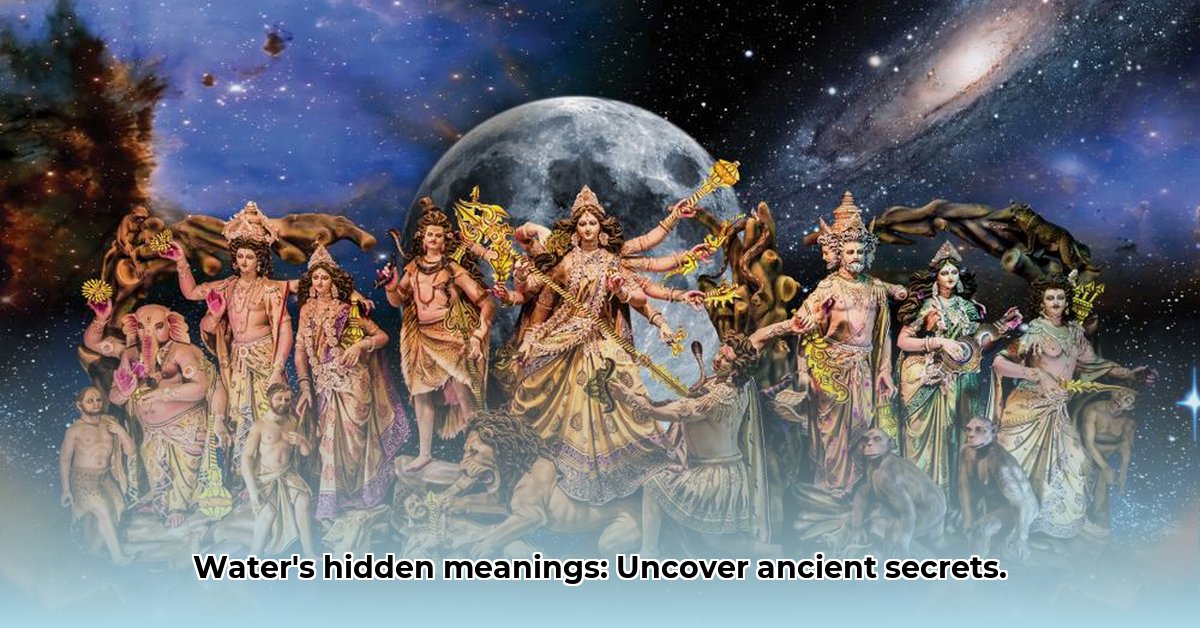
Water: A Universal Symbol in Mythological Narratives
Water, far from being a mere backdrop in mythology, serves as a potent and multifaceted symbol, reflecting humanity's complex relationship with this life-giving and often destructive force. From the primordial oceans of creation to the cleansing floods of divine judgment, water's symbolic resonance reverberates across diverse cultures and millennia. This exploration delves into the rich tapestry of water symbolism in mythology, highlighting both common themes and fascinating cultural variations. We’ll examine how different societies have imbued water with meaning, drawing parallels and illuminating the unique perspectives shaped by geography, environment, and cultural practice. For more on water symbolism, check out this great resource.
The Duality of Water: Creation and Destruction
Many creation myths depict a chaotic, watery primordial state – think of the Egyptian Nun, a boundless expanse of water from which all existence emerged. This initial chaos, however, doesn't merely represent the beginning, but often foreshadows the potential for destruction. The Babylonian goddess Tiamat, a monstrous sea serpent, embodies this duality, symbolizing both the generative power of creation and the terrifying force of annihilation. This intrinsic duality – water as both womb and tomb, source of life and instrument of devastation – is a cornerstone of its enduring symbolic power. Isn't it remarkable how a single element encompasses such seemingly contradictory meanings? The pervasive presence of flood myths, such as the Epic of Gilgamesh and Noah's Ark narrative, further underscores this duality, portraying catastrophic floods as both divine judgment and opportunities for renewal.
Water as Purification and Rebirth
The cleansing power of water appears repeatedly across various belief systems. In Christianity, baptism signifies the washing away of sins, marking a spiritual rebirth. Similarly, in Hinduism, ritual bathing in sacred rivers like the Ganges is a deeply significant act of purification and spiritual cleansing. This widespread association of water with purification and renewal reflects a universal human desire for cleansing and regeneration, both physically and spiritually. This shared symbolic element transcends geographical and cultural boundaries, underscoring the fundamental nature of this association. Did you know that, according to some estimations, over 90% of cultures incorporate water into some form of purification ritual?
Cultural Variations in Water’s Symbolic Depiction
While the core symbolic themes surrounding water display remarkable consistency across cultures, specific interpretations are significantly shaped by cultural context and environmental factors. Consider the contrast between Poseidon, the tempestuous and unpredictable Greek god of the sea, and gentler, more benevolent water deities found in other mythologies. Coastal societies, heavily reliant on the sea, often feature powerful sea gods associated with navigation and fishing, reflecting their intimate connection with the ocean’s bounty and capricious nature. In contrast, agricultural societies, whose livelihoods depend on the availability of fresh water for irrigation, tend to view water deities as providers of life and fertility, exemplified by the reverence for the Nile in ancient Egyptian mythology. Professor Anya Petrova, a leading anthropologist at the University of Oxford, notes that “the specifics of water symbolism in mythology are inherently linked to the relationship between a society and its water sources.” This shows that the way a society interacts with water inherently shapes its symbolic meaning within their mythical narratives.
Water as a Liminal Space: Between Worlds
Water frequently functions as a boundary—a threshold between different realms of existence. The River Styx in Greek mythology, for instance, separates the world of the living from the underworld, symbolizing the transition between life and death. This liminal quality of water is further emphasized in Dante’s Inferno, where the Styx is depicted as a swamp of moral decay, deepening the symbolic weight of this watery boundary. This example illustrates how the cultural context dramatically influences the interpretation of water symbolism. Its meaning is not static but fluid and dynamic, molded by the cultural lens through which it is viewed. This dynamic nature adds to the ongoing fascination surrounding water's multifaceted symbolism.
Conclusion: The Enduring Power of Water's Symbolism
The study of water symbolism in mythology offers a rich tapestry of human experience and cultural understanding. From the primordial chaos of creation to the cleansing properties of purification rituals and the liminal spaces between worlds, water’s symbolic presence consistently reflects humanity's enduring fascination with its power and its duality. As we continue to explore the diverse interpretations imbued with this fundamental element, we uncover deeper insights into the human condition and our inextricable connection to the natural world. The investigation into water’s symbolic power is an ongoing journey of discovery, ripe with further research possibilities and opportunities for nuanced understanding.
Key Takeaways:
- Water’s symbolic representation in mythology reflects a multifaceted relationship— life-giving, destructive, purifying, and liminal.
- Cultural variations in water symbolism are influenced by geographical location, societal practices, and environmental factors.
- Flood myths across cultures highlight the duality of water, signifying both destruction and renewal.
- Future research should explore diverse perspectives, including those of indigenous cultures, to further illuminate water's symbolic power.